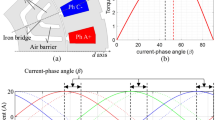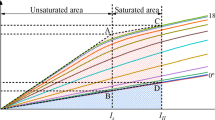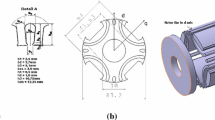Abstract
Multiple air barriers and iron webs of the synchronous reluctance motor (SynRM) are vital to achieving higher average torque and a lower ripple torque. However, it is challenging to determine the optimum multiple barriers because the optimization results are significantly affected by the initial flux path and moreover are sensitive to a penalization scheme in the topology optimization. Interestingly, in nature, the hollow circular patterns of the trabecular bone at infancy gradually adapt to the optimal (also very complicated) trabecular architecture, which provides a characteristic lightweight design. Inspired by the above observation, this study proposed a novel topology optimization for multiple-barrier SynRMs, which initially started from random hollow circles. To distinguish between iron and air, the dq-axis-dependent penalization scheme is also proposed instead of a conventional spatially constant penalization scheme. Using the adjoint variable method, the analytical sensitivity was derived to consider a nonlinear B-H curve in the topology optimization. By optimizing various SynRMs with different filtering radii, this study investigated the relationship between multiple barriers and motor performance.














Similar content being viewed by others
References
Kostko JK (1923) Polyphase reaction synchronous motors. J Am Ins Electr Eng 42(11):1162–1168
Staton DA, Miller TJE, Wood SE (1993) Maximising the saliency ratio of the synchronous reluctance motor. IET Proc B 140(4):249–259
Fratta A, Troglia G P, Vagati A, Villata F (1993) Evaluation of torque ripple in high performance synchronous reluctance, Conference Record of the IEEE Industry Applications Society Annual Meeting
Matsuo T, Lipo TA (1994) Rotor design optimization of synchronous reluctance machine. IEEE Trans Energy Conv 9(2):359–365
Vagati A, Pastorelli M, Francheschini G, Petrache SC (1998) Design of low-torque-ripple synchronous reluctance motors. IEEE Trans Ono Indu Appl 34(4):758–765
Kim KC, Ahn JS, Won SH, Hong JP, Lee J (2007) A study on the optimal design of SynRM for the high torque and power factor. IEEE Trans Magn 43(6):2543–2545
Taghavi S, Pillay P (2014) A sizing methodology of the synchronous reluctance motor for traction applications. IEEE J Emerg Select Topics Power Electron 2(2):329–340
Moghaddam R, Gyllensten F (2014) Novel high-performance SynRM design method an easy approach for a complicated rotor topology. IEEE Trans Ind Electron 61(9):5058–5065
Tessarolo A (2015) Modeling and analysis of synchronous reluctance machines with circular flux barriers through conformal mapping. IEEE Trans Magn 51(4):1–11
Sanada M, Hiramoto K, Morimoti S, Takeda Y (2004) Torque ripple improvement for synchronous reluctance motor using an asymmetric flux barrier arrangement. IEEE Trans Ind Appl 40(4):1076–1082
Bianchi N, Bolognani S, Bon D, Dai PM (2009) Rotor flux-barrier design for torque ripple reduction in synchronous reluctance and PM-assisted synchronous reluctance motors. IEEE Trans Indu Appl 45(3):921–928
Ferrari M, Bianchi N, Doria A (2015) Design of synchronous reluctance motor for hybrid electric vehicles. IEEE Trans Ind Appl 51(4):3030–3040
Kamper MJ, Van der Merwe FS, Williamson S (1996) Direct finite element design optimisation of the cageless reluctance synchronous machine. IEEE Trans Energy Conv 11(3):547–555
Park JM, Kim SI, Hong JP, Lee JH (2006) Rotor design on torque ripple reduction for a synchronous reluctance motor with concentrated winding using response surface methodology. IEEE Trans Magn 42(10):3479–3481
Choi YC, Kim H, Lee J (2008) Optimum design criteria for maximum torque density and minimum torque ripple of SynRM according to the rated wattage using response surface methodology. IEEE Trans Magn 44(11):4135–4138
Cupertino F, Pellegrino G, Gerada C (2014) Design of synchronous reluctance motors with multiobjective optimization algorithms. IEEE Trans Ind Appl 50(6):3617–3627
Pellegrino G, Cupertino F, Gerada C (2015) Automatic design of synchronous reluctance motors focusing on barrier shape optimization. IEEE Trans Ind Appl 51(26):1465–1474
Bao Y, Degano M, Wang S, Chuan L, He Z, Xu Z, Gerada C (2019) A novel concept of ribless synchronous reluctance motor for enhanced torque capability. IEEE Trans Ind Electron 67(4):2553–2563
Kim YS, Park IH (2010) Topology optimization of rotor in synchronous reluctance motor using level set method and shape design sensitivity. IEEE Trans Appl Supercond 20(3):1093–1096
Sato S, Sato T, Igarashi H (2015) Topology optimization of synchronous reluctance motor using normalized Gaussian network. IEEE Trans Magn 51(3):1–4
Watanabe K, Suga T, Kitabatake S (2017) Topology optimization based on the ON/OFF method for synchronous motor. IEEE Trans Magn 51(3):1–4
Bendsøe MP (1989) Optimal shape design as a material distribution problem. Structural Optim 1(4):193–202
Zhou M, Rozvany GIN (1991) The COC algorithm, part II: topological, geometry and generalized shape optimization. Comput Methods Appl Mech Eng 89(1–3):309–336
Lee J, Seo J H, Kikuchi N (2010) Topology optimization of switched reluctance motors for the desired torque profile.Structural and multidisciplinary optimization 42(5): 783-796
Lee J (2019) Multiscale finite element analysis of linear magnetic actuators using asymptotic homogenization method. Multi Sci Eng 1(1):70–75
Lee J, Yoo J, Min S, Yoon M (2019) Topology optimization of anisotropic magnetic composites in actuators using homogenization design method. Struct Multidiscip Optim 60(4):1423–1436
Tsubota K, Adachi T, Tomita Y (2002) Functional adaptation of cancellous bone in human proximal femur predicted by trabecular surface remodeling simulation toward uniform stress state. J Biomech 35(12):1541–1551
Jang IG, Kim IY, Kwak BM (2009) Analogy of strain energy density based bone-remodeling algorithm and structural topology optimization. J Biomech Eng 131(1):011012
Jang IG, Kim IY (2008) Computational study of Wolff’s law with trabecular architecture in the human proximal femur using topology optimization. J Biomech 41(11):2353–2361
Jang IG, Kim IY (2009) Computational simulation of trabecular adaptation progress in human proximal femur during growth. J Biomech 42(5):573–580
Jang IG, Kim IY (2010a) Application of design space optimization to bone remodeling simulation of trabecular architecture in human proximal femur for higher computational efficiency. Finite Elem Anal Des 46(4):311–319
Jang IG, Kim IY (2010b) Computational study on the effect of loading alteration caused by disc degeneration on the trabecular architecture in human lumbar spine. J Biomech 43(3):492–499
Jang IG, Kim IY (2010c) Computational simulation of simultaneous cortical and trabecular bone change in human proximal femur during bone remodeling. J Biomech 43(2):294–301
Christopher Boyle (2010) Computational study of Wolff’s law utilizing design space topology optimization: a new method for hip prosthesis design, Master Thesis, Queen’s University
Jasbir AS, Edward JH (1979) Methods of design sensitivity analysis in structural optimization. AIAA J 17(9):970–974
Gitosusastro S, Coulomb JL, Sabonnadiere JC (1989) Performance derivative calculations and optimization process. IEEE Trans Magn 25(4):2834–2839
Park IH, Lee B, Hahn S (1992) Design sensitivity analysis for nonlinear analysis for magnetostatic problems using finite element method. IEEE Trans Magn 28(2):1533–1536
Wang X, Wang XB, Gascoyne PR (1997) General expressions for dielectrophoretic force and electrorotational torque derived using the Maxwell stress tensor method. J Electrost 39(4):277–295
Svanberg K (1987) The method of moving asymptotes—a new method for structural optimization. Int J Numer Methods Eng 24(2):359–373
Svanberg K (2002) A class of globally convergent optimization methods based on conservative convex separable approximations. SIAM J Optim 12(2):555–573
Sigmund O (1994) Design of material structures using topology Optimization,” Ph.D. Thesis, Department of Solid Mechanics, Technical University of Denmark
Acknowledgements
The authors would like to thank Dr. Krister Svanberg at KTH (Stockholm, Sweden) for providing the MMA code for academic research.
Funding
This research was supported by the grant (Development of a Small-scale Hybrid Electric Propulsion System for Diesel Fishing Boats and its performance validation), funded by Korea Maritime Transportation Safety Authority (KOMSA), South Korea.
Author information
Authors and Affiliations
Corresponding author
Ethics declarations
Conflict of interest
The authors declare that they have no conflict of interest.
Replication of results
All the presented results can be replicated, and all the necessary data sets and a flowchart for the problems are presented in the manuscript. The software used in this study is protected by Korea Maritime Transportation Safety Authority of Korean government. Due to this confidential issue, we cannot share the software publicly.
Additional information
Responsible Editor: Gregoire Allaire
Publisher's note
Springer Nature remains neutral with regard to jurisdictional claims in published maps and institutional affiliations.
Appendices
Appendix 1. Finite element analysis for electromagnetic problems
To solve electromagnetic problems, (3) is discretized and then converted to (22). In (22), the subscripts i and j refer to the ith and jth nodes, respectively. Under constant Q, (22) can be solved to determine a nodal vector potential (Az,j) at the jth node after the error vector (\( {\mathtt{\varepsilon}}_i^{\left(\varpi \right)} \)) converges within tolerance, as follows:
where \( {\mathbf{K}}^{\left(\varpi \right)}=\left[\begin{array}{cccc}{K}_{11}^{\left(\varpi \right)}& {K}_{12}^{\left(\varpi \right)}& \cdots & {K}_{1n}^{\left(\varpi \right)}\\ {}{K}_{21}^{\left(\varpi \right)}& {K}_{22}^{\left(\varpi \right)}& \cdots & {K}_{2n}^{\left(\varpi \right)}\\ {}\cdots & \cdots & \ddots & \cdots \\ {}{K}_{n1}^{\left(\varpi \right)}& {K}_{n2}^{\left(\varpi \right)}& \cdots & {K}_{nn}^{\left(\varpi \right)}\end{array}\right] \);\( {\mathbf{A}}_z^{\left(\varpi \right)}={\left[{\mathbf{A}}_{\mathrm{z},1}^{\left(\varpi \right)},{\mathbf{A}}_{\mathrm{z},2}^{\left(\varpi \right)},\cdots, {\mathbf{A}}_{\mathrm{z},n}^{\left(\varpi \right)}\right]}^{\mathrm{T}} \); Q = [Q1, Q2, ⋯, Qn]T; \( {\boldsymbol{\upvarepsilon}}^{\left(\varpi \right)}={\left[{\boldsymbol{\upvarepsilon}}_1^{\left(\varpi \right)},{\boldsymbol{\upvarepsilon}}_2^{\left(\varpi \right)},\cdots, {\boldsymbol{\upvarepsilon}}_n^{\left(\varpi \right)}\right]}^{\mathrm{T}} \); ϖ is the iteration number of the Newton-Raphson method; n and mmax are the total numbers of nodes and elements, respectively, used in the FE analysis; K(ϖ) is a n × n system matrix; Nm, i and Nm, j are the shape functions at the ith and jth node, respectively, in the mth element; |Gm| is the Jacobian of the mth element, and um and vm are the local coordinates of the mth element. The system matrix (K(ϖ)) includes information on the nonlinear reluctivity and mesh connectivity, as follows:
where \( {\overline{N}}_{m,i,j}=\left(\frac{\partial {N}_{m,i}}{\partial x}\frac{\partial {N}_{m,j}}{\partial x}+\frac{\partial {N}_{m,i}}{\partial y}\frac{\partial {N}_{m,j}}{\partial y}\right) \) and νm = νm(‖Bm‖). The electric forcing function (Qi) at the ith node is expressed as
Then, the error vector (\( {\boldsymbol{\upvarepsilon}}_i^{\left(\varpi \right)} \)) at the ith node can be represented, as follows:
where \( {\tilde{K}}_{il}^{\left(\varpi \right)}=\sum \limits_{j=1}^n\frac{\partial {K}_{ij}^{\left(\varpi \right)}}{\partial {\mathbf{A}}_{z,l}^{\left(\varpi \right)}}{\mathbf{A}}_{\mathrm{z},j}^{\left(\varpi \right)} \). Note that the n × n matrix (\( {\tilde{\mathbf{K}}}^{\left(\varpi \right)} \)) represents the response of the system matrix (K(ϖ)) with respect to the vector potential (\( {\mathbf{A}}_{z,j}^{\left(\varpi \right)} \)).
Appendix 2. Adjoint variable for Maxwell’s stress tensor-based electromagnetic torque
The adjoint variable method has been widely used to solve structural problems (Jasbir and Edward 1979) and electromagnetic problems (Gitosusastro et al. 1989; Park et al. 1992). If (22) converges within a tolerance, the total derivative of (22) with respect to the design variable (ρe) can be expressed, as follows:
Note that, in this study, the coil area is not included as the design domain. Therefore, \( d{\mathbf{Q}}_i/d{\rho}_e \) becomes zero. Then, the first term in (26) can be re-expressed using the matrix (D = [D1, D2, ⋯, Dn]T), as
where \( \frac{\partial {\left(\sum \limits_{j=1}^n{\mathbf{K}}_{ij}{A}_{z,j}\right)}_{A_z,{\rho}_e=\mathrm{const}}}{\partial {\nu}_e^{\left(\mathrm{SIMP}\right)}}={\left.\sum \limits_{j=1}^n\sum \limits_{e=1}^{m_{\mathrm{max}}}{\int}_{\Omega_e}{\overline{N}}_{e,i,j}{\boldsymbol{A}}_{z,j}\left|{G}_e\right|{du}_e{dv}_e\right|}_{{\boldsymbol{A}}_z,{\rho}_e=\mathrm{const}} \) and \( \frac{\partial {v}_e^{\left(\mathrm{SIMP}\right)}}{\partial {\rho}_e}=p{\rho}_e^{p-1}\left({v}^{\left(\mathrm{iron}\right)}\left(\left\Vert {\mathbf{B}}_e\right\Vert \right)-{v}^{\left(\mathrm{air}\right)}\right)+{\rho}_e^p\frac{\partial {v}^{\left(\mathrm{iron}\right)}\left(\left\Vert {\mathbf{B}}_e\right\Vert \right)}{\partial {\rho}_e} \). The second term in (26) can also be re-expressed using \( {\tilde{K}}_{il}^{\left(\varpi \right)} \) which is obtained from the FE analysis, as
Through the above procedure, (26) can be simplified as follows:
In general, the computation of ∂Az, l/∂ρe in (29) requires high computing cost. To reduce such computing cost, an adjoint variable (λi) is multiplied to both sides of (29) as
In this study, the adjoint variable is defined as follows:
where T(θk, ρ) is Maxwell’s stress tensor (MST)–based torque. Using the adjoint variable method, the torque response with respect to the design variable can be easily calculated without the heavy computation of ∂Az, l/∂ρe, as
where λ = [λ1, λ2, ⋯, λn]T is an n × 1 adjoint variable vector.
Note that the integration boundary for the MST is not included as the design domain. Therefore, ∂T(θk, ρ)/∂ρe becomes zero. Finally, the derivative of the torque with respect to the design variable is expressed, as follows:
Rights and permissions
About this article
Cite this article
Lee, C., Jang, I.G. Topology optimization of multiple-barrier synchronous reluctance motors with initial random hollow circles. Struct Multidisc Optim 64, 2213–2224 (2021). https://doi.org/10.1007/s00158-021-02976-2
Received:
Revised:
Accepted:
Published:
Issue Date:
DOI: https://doi.org/10.1007/s00158-021-02976-2




